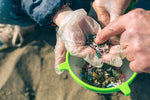
Microplastics: A Growing Environmental Menace
, by Planet Green, 11 min reading time

, by Planet Green, 11 min reading time
Becoming aware and proactive in our choices as consumers is a critical step in combating the proliferation of microplastics.
Microplastics, the tiny plastic particles that have stealthily infiltrated our environment, now pose a serious and growing threat to our planet. Measuring less than 5mm in size, these inconspicuous pollutants have found their way into our oceans, rivers, and even the air we breathe, sparking concerns about their impact on ecosystems and human health.
Microplastics may be tiny, but their origins are vast and diverse. They result from a combination of intentional manufacturing and the breakdown of larger plastic items due to environmental forces. We categorize them into two different categories, neither less impacting than the other.

1. Primary Microplastics:
Primary microplastics are deliberately produced as small particles for various industrial and consumer applications. Some common sources of primary microplastics include:
2. Secondary Microplastics:
Secondary microplastics result from the degradation of larger plastic items, such as plastic bottles, bags, and packaging, under the influence of environmental factors. Here's how this breakdown occurs:
Understanding the origins of microplastics is a crucial step in addressing this issue comprehensively. By recognizing the sources, we can develop targeted strategies to reduce their generation and prevent further contamination of our environment.

Microplastics have silently infiltrated our oceans, becoming a pervasive threat to marine ecosystems and wildlife. Understanding how these tiny plastic particles find their way into the marine environment, and their profound impact on ecological health and marine life, is essential to addressing this pressing issue.
How Microplastics Enter Our Oceans:
Ecological Impact of Microplastics:
Microplastics wreak havoc on marine ecosystems in various ways, posing a multifaceted threat:
Impact on Marine Life:
Beyond the polluted oceans and waterways, microplastics have stealthily infiltrated our food chain, raising concerns about their impact on human health and the broader ecosystem. These tiny plastic particles make their way into the food we eat and pose risks to our well-being.
How Microplastics Enter the Food Chain:
Ecological Impact on the Food Chain:
Impact on Human Health:
The environmental impact of our reliance on plastic production has reached critical levels, demanding our immediate attention and action. It’s important as consumers that we identify a pivotal strategy in our battle against plastic pollution by reducing the production of plastics. By examining the significance of curbing plastic production and exploring ways to limit its environmental footprint, we can take a leap toward a more sustainable and plastic-responsible future.
Enhancing Waste Management
Innovative Cleanup Technologies
Consumer Awareness and Responsibility
In the battle against the spread of microplastics, consumers play a pivotal role as the first line of defense. By becoming more aware and proactive in our consumption and use of single-use plastic items, we can significantly mitigate the impact of these persistent pollutants on our environment.
1. Educate Yourself: The journey toward being a conscious consumer begins with education. Stay informed about the life cycle of single-use plastics and their potential to become microplastics. Understand the implications of their use and disposal on the environment, including the harm they pose to marine life and ecosystems. Recognize that the convenience of these items often comes at a high cost to nature.
2. Reduce Single-Use Plastics: Embrace the mantra of "reduce, reuse, recycle." Start by identifying and reducing your consumption of single-use plastic items, such as disposable cutlery, straws, and shopping bags. Choose reusable alternatives instead. Investing in a set of reusable bags, a stainless steel water bottle, and bamboo utensils can significantly cut down your plastic waste.
3. Make Informed Choices: When shopping for products, scrutinize labels and packaging materials. Opt for items with minimal plastic packaging or those made from sustainable, eco-friendly materials. Support brands that prioritize reducing their plastic footprint and are actively working toward sustainable packaging solutions.
4. Advocate for Change: Don't underestimate the power of your voice and choices as a consumer. Engage in discussions with friends, family, and communities about the importance of reducing single-use plastics and the consequences of microplastics pollution. Encourage businesses and policymakers to adopt plastic-reduction measures and promote the adoption of eco-friendly alternatives.
5. Responsible Recycling: Properly dispose of recyclable materials, including plastics, in accordance with local recycling guidelines. Educate yourself about what can and cannot be recycled in your area to ensure your efforts have a positive impact.
6. Be Mindful of Microfibers: Recognize that microplastics aren't only found in single-use items but also originate from synthetic textiles. Invest in a microfiber-catching laundry bag to reduce the release of microfibers during washing, preventing them from entering the environment.
Becoming aware and proactive in our choices as consumers is a critical step in combating the proliferation of microplastics. Share information about reducing the reliance on single-use plastics, making informed choices, advocating for change, and practicing responsible recycling. Collectively, we take meaningful strides toward a future where our environment is spared from the enduring harm of microplastics. It isn’t the responsibility of manufacturing alone to make changes, it starts with individual actions by consumers and those actions will drive change in the industry.

Pinellas County, Florida, has taken a significant step in combating plastic waste by adding Planet Green Recycle to its public-facing information website. Residents and businesses...

The Holiday Spirit Meets Sustainability The holiday season is a time for giving, celebrating, and creating memories. It’s also a time when we tend to...

With November 15th being celebrated as America Recycles Day, the Plastics Industry Association (PLASTICS) commemorates Recycling Week this year from November 11th through November 15th...

Plastic pollution has become one of the most pressing environmental issues of our time, impacting land, waterways, and marine life on a global scale. While...